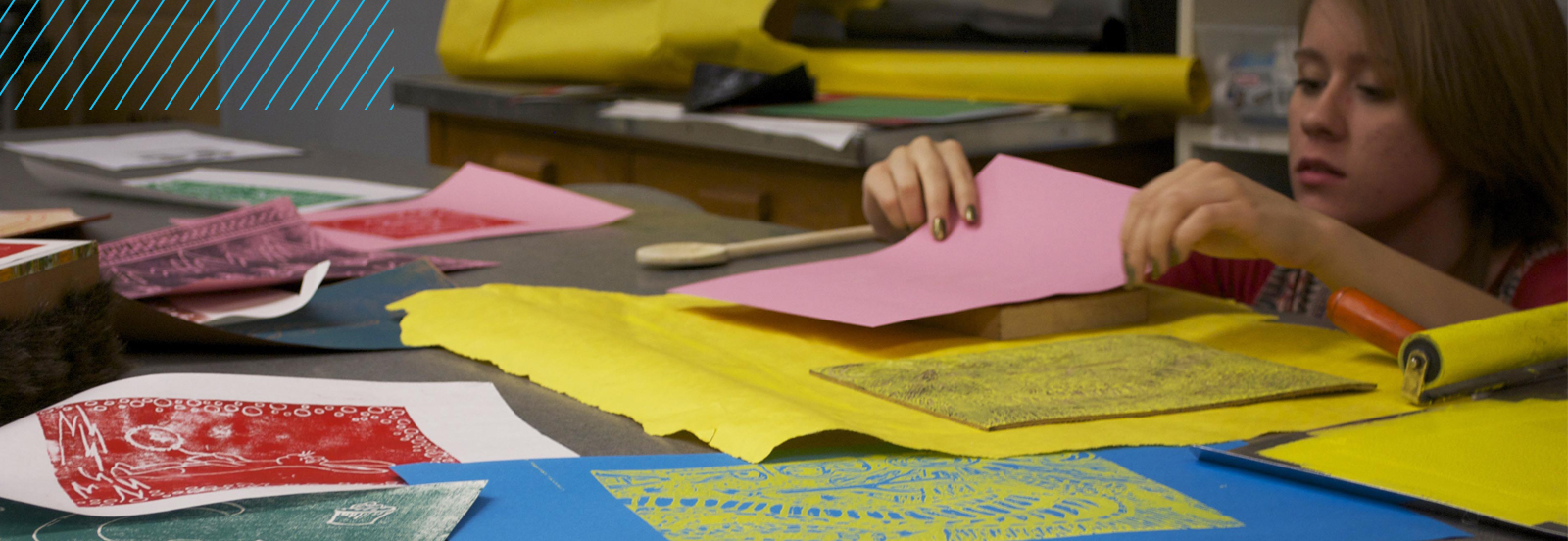Department of Art and Design
Art - Art Education, B.F.A

Art education is about helping students develop a deep appreciation and understanding of art as a form of human expression. It requires a deep knowledge of art history, theory, and practice, as well as an ability to create engaging and meaningful learning experiences for students.
Overview
In the art education concentration, students focus on developing the knowledge, skills, and pedagogical approaches necessary to become effective art teachers. The program encompasses a combination of artistic exploration, pedagogical theory, practical teaching and civic engagement experiences.
Students in the program begin by establishing a strong foundation in various media, including drawing, painting, sculpture, ceramics, and printmaking. They develop their own artistic skills, experiment with different techniques, and gain a deep understanding of the creative process. This artistic proficiency enables them to serve as role models and guides for their future students.
Simultaneously, students delve into the theoretical and practical aspects of education. They study educational psychology, learning theories, and instructional strategies specifically tailored to the art classroom. They learn how to design lesson plans, create curriculum frameworks, and adapt teaching methods to accommodate diverse learners and their unique needs. Understanding child and adolescent development, as well as educational assessment and evaluation techniques, are also emphasized.
Students gain practical experience through observation and teaching placements in schools or educational settings. They observe experienced teachers, assist in classroom management, and gradually take on teaching responsibilities under supervision. These experiences allow them to apply their knowledge and skills in real-world teaching contexts, fostering their ability to create engaging and effective art lessons.
Within the program, students also explore the integration of technology in art education, discovering how digital tools and resources can enhance the teaching and learning process. They learn how to incorporate digital art-making, multimedia presentations, and online platforms into their lessons, fostering digital literacy skills alongside traditional artistic techniques.
Another critical aspect of an art education program is the exploration of diversity, inclusivity, and multiculturalism in art classrooms. They learn how to incorporate diverse perspectives, artists, and art forms from various cultures, ensuring that their future classrooms are inclusive and culturally responsive.
Throughout the program, students have opportunities for reflection, discussion, and collaboration with peers and faculty. They engage in critique sessions, exploring the ethical, philosophical, and social dimensions of art education. Additionally, they develop their own teaching philosophies and build a portfolio that showcases their growth as artists, educators, and advocates for the arts in education.
The program leads to being certified to teach art K-12 in Tennessee and includes taking classes in the College of Education, being admitted to the Teacher Education Program (TEP), Residency 1 and 2 and passing Praxis exams.
Curriculum and Concentration Requirements
Please review the official academic catalog for comprehensive information on requirements.
Careers
Concentrating in art education opens a wide range of careers in the arts and creative industries. Possible career paths for students concentrating in art education:
- K-12 Art Teacher: Art education majors can pursue careers as K-12 art teachers in public or private schools. They teach students various art techniques, such as drawing, painting, sculpture, and digital art, and help them develop their artistic skills and creativity.
- Museum Educator: Museum educators work in museums and art galleries to develop and deliver educational programs and activities for visitors of all ages. They use their knowledge of art history to help visitors understand and appreciate the artworks on display.
- Community Arts Program Coordinator: Art education majors can work for community organizations or nonprofits to develop and implement art programs for people of all ages. They may work with underserved communities or specific populations, such as seniors or children.
- Curriculum Developer: Art education majors can work for educational publishing companies or nonprofits to develop art curriculum and educational materials for K-12 schools. They may work with a team of educators and artists to create engaging and effective art lessons and activities.
- Art Program Director: Art program directors oversee art programs in schools, community organizations, or nonprofit organizations. They develop program goals, hire and train staff, manage budgets, and evaluate program effectiveness.
- Arts Administrator: Arts administrators work in art organizations, such as museums, galleries, and performing arts centers, to manage budgets, develop programming, and oversee staff. They may also work for government agencies or nonprofit organizations that fund the arts.
Depending on students’ interests and skills, their knowledge of art techniques and art history, along with their teaching skills, can be applied in many different ways.
Facilities
ACB Room 112, 796 SQ FT
- Art Education books
- Table
- Chairs
- 3-D printers
- Art Education curriculum materials
ACB Room 114, 1086 SQ FT
- 1 Mac
- 1 Projector
- 1 Paper Cutter
- Art Education supplies
- Sink
- Table
- Chairs
ACB Room 137, 758 SQ FT
- 1 Mac
- 1 Projector
- 1 Paper Cutter
- Art Education supplies
- Sink
- Table
- Chairs
- Art Education books
